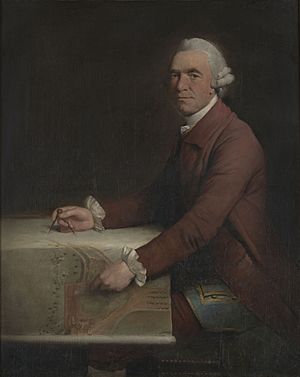Kenton Couse facts for kids
Quick facts for kids
Kenton Couse
|
|
|---|---|
 |
|
| Born | 1 March 1721 Bermondsey, London, England
|
| Died | 10 October 1790 (aged 69) |
| Occupation | Architect |
| Projects | 10 Downing Street Richmond Bridge Normanton Hall Holy Trinity Church, Clapham |
Kenton Couse (born March 1, 1721 – died October 10, 1790) was an important English architect. He learned his skills by working for another famous architect, Henry Flitcroft. This helped him get jobs in the government's "Office of Works," which was in charge of royal buildings. Later, Couse became the Secretary for the Board of Works. His most well-known project was redesigning 10 Downing Street between 1766 and 1775.
Contents
Early Life and Career
Kenton Couse was born on March 1, 1721. He was the oldest son of Josias Couse, who worked as a goldsmith (someone who makes things from gold) and a linen draper (a seller of fabrics) in Cheapside, London. His mother was Margaret.
Couse learned a lot about architecture from his mentor, Henry Flitcroft. This training helped him get important positions. He worked for the "Office of Works," a government department. This office was responsible for building and maintaining royal palaces and other public buildings.
Famous Projects
Kenton Couse is best known for his work on several important buildings and structures. His designs often featured the simple and elegant Georgian architecture style.
10 Downing Street Redesign
One of Couse's most famous projects was the redesign of 10 Downing Street. This building is now the official home and office of the Prime Minister of the United Kingdom. In 1756, a politician named Charles Townshend asked Couse to update the building's entrance.
Couse designed a simple, narrow doorway in the Georgian style. It featured a single white stone step. This work was likely finished around 1772. The famous black door we see today is based on his design.
Bridges and Other Buildings
Couse also worked on several other significant projects:
- Richmond Bridge: He helped design the Richmond Bridge in London. This beautiful stone arch bridge crosses the River Thames.
- Chertsey Bridge: He was the surveyor for Chertsey Bridge in Surrey. A surveyor checks the measurements and layout of a construction project.
- Normanton Hall: Couse designed Normanton Hall in Rutland. This grand house has since been taken down.
- Holy Trinity Church: He was the architect for Holy Trinity Church, Clapham. This church was officially opened in 1776.
Later Career
Couse continued his work in the Office of Works. From 1775 to 1782, he served as the Secretary to the Board of Works. This was a key role in managing government construction projects. Kenton Couse passed away on October 10, 1790. His architectural legacy can still be seen in London and other parts of England.

